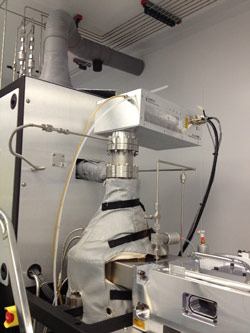- News
30 July 2013
Bilkent University upgrades ALD system with Meaglow’s hollow cathode plasma source
Meaglow Ltd of Thunder Bay, Ontario, Canada, a privately held firm that produces epitaxy equipment and molecular beam epitaxy (MBE) and metal organic chemical vapour deposition (MOCVD) accessories, as well as providing specialized thin films to research institutes and industry, has announced the installation of a hollow cathode plasma source for the group of professor Necmi Biyikli of the Institute of Materials Science and Nanotechnology, at Bilkent University in Turkey. The plasma source is being used to upgrade the group’s atomic layer deposition (ALD) system by replacing an inductively coupled plasma source. Meaglow says that the enhancement will reduce the oxygen contamination in the ALD system and increase the quality of nitride thin films grown.
 Picture: Meaglow installs hollow cathode plasma source to upgrade ALD system.
Picture: Meaglow installs hollow cathode plasma source to upgrade ALD system.
"The Bilkent system was easy to retrofit and the Meaglow Plasma source was the perfect solution for their oxygen contamination problem," says Meaglow’s chief scientist, Dr Butcher.
Initial results show a significant reduction of oxygen content in compound nitride films grown. Results will be presented at the 224th ECS Fall Meeting in San Francisco, CA, USA (27 October -1 November) at an invited talk presented in the symposium on ‘Atomic Layer Deposition Applications’.
Meaglow is focused on commercializing its hollow cathode plasma technology, and is seeking additional ALD system owners and suppliers interested in removing the oxygen contamination in their films. The Plasma source can be used to retrofit existing systems or can be integrated with equipment manufacturers. The plasma source can be utilized in a number of different applications including MBE, and low-pressure metal-organic chemical vapor deposition (LPMOCVD), among others.





